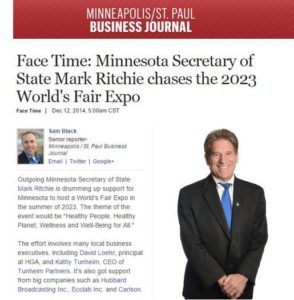Editorial by James Ogul
The good news:
On 4 May 2017, the US Congress passed the “U.S. WANTS TO COMPETE FOR A WORLD EXPO ACT” which requires the Secretary of State to take such actions as may be necessary for the United States to rejoin the Bureau of International Expositions (BIE), the international sanctioning body for world’s fairs. The next step needed to complete the process is the President’s signature, after which documents would be filed with the French Embassy (the BIE is headquartered in Paris).
Re-joining the BIE paves the way for Minnesota’s bid to move forward with a chance of success. We applaud this and hope to see a successful result. There has not been a world’s fair hosted in the United States since the Louisiana World Exposition of 1984, in New Orleans. The last world expo in North America was Vancouver Expo 86. Numerous world expos have been hosted abroad since 1988, in Australia, Europe and Asia.
U.S. membership in the BIE was allowed to lapse in 2001. While this did not prevent U.S. participation in recent expos abroad – including Aichi 2005, Shanghai 2010, Yeosu 2012, Milan 2015 and Astana 2017 – it has been a barrier to a world’s fair being held on U.S. soil. A bid to host a world’s fair from a BIE member nation has a much better chance of making it through the process, aided by support from its own federal government.
Mark Ritchie, President and CEO of Minnesota World’s Fair, said, “The bi-partisan leadership on this issue in Congress was alongside very strong support from the White House, the Commerce Department and the State Department. The federal government expressed their strong backing not only of Minnesota’s bid but for the future hopes of other cities like Houston, Los Angeles, Philadelphia, and San Francisco. This is the beginning of a new golden era for world expositions here in the United States and I am proud that Minnesota can lead the way.”
A prohibitive clause
As mentioned above, the U.S. left the BIE in 2001, and that withdrawal has undermined the efforts of U.S. entities desiring to host a world’s fair. The new legislation is a positive step toward changing the situation.
But at the same time, the legislation contains a clause likely to present significant obstacles to U.S. participation in future expos abroad. (There are many benefits to participating in world’s fairs, as well as hosting them. We have written often about the subject in this forum.)
The prohibitive clause appears under Section 5 and states:
(b) Prohibition on Solicitation of Funds.–Section 204(b)(1)(C) of the Admiral James W. Nance and Meg Donovan Foreign Relations Authorization Act, Fiscal Years 2000 and 2001 (22 U.S.C. 2452b(b)(1)(C)) is amended by inserting after “expositions” the following: “…except that no employees of the Department of State may, in their official capacity, solicit funds to pay expenses for a United States pavilion or other major exhibit at any international exposition or world’s fair registered by the Bureau of International Expositions.”

This prohibition could very well end U.S. participation in world’s fairs overseas. U.S. participation in world expos flagged around the turn of the century, then turned around, with a creditable presence at Shanghai 2010, Yeosu 2012 and Milan 2015 as noted above.
For the U.S. Pavilion at Astana Expo 2017, opening June 10, the bulk of the funding was raised from the private sector by State Department officials. Private sector engagement has long been an essential element for U.S. pavilions at world’s fairs, and the direct involvement of senior State Department officials is key. The cost of producing an expo pavilion can sometimes rise to the level of $60 million plus for the larger world’s fairs. Many people at State and the Commerce Department (for domestic expos) have been engaged in fundraising for expos going back decades.
On multiple past projects, the U.S. State Department has done a great job making sure the U.S. is well represented at world’s fairs at no expense to the taxpayer. Senior State Department Officials are able to effectively communicate the many ways in which Expo participation promotes U.S. businesses, products, tourism, and culture to raise private sector funds for U.S. pavilions. Historically, when State Department officials are part of this process, such fundraising has been successful – and when they have not, it has not. Experience has shown this again and again. The prohibition against State Department officials soliciting funds in the “U.S. WANTS TO COMPETE FOR A WORLD EXPO ACT” is troubling.







